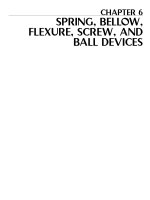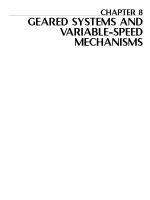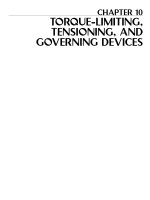McGraw-Hill - Robot Mechanisms and Mechanical Devices Illustrated - 2003 Part 13 potx
Bạn đang xem bản rút gọn của tài liệu. Xem và tải ngay bản đầy đủ của tài liệu tại đây (626.54 KB, 25 trang )
This page intentionally left blank.
M
echanical limit switches are devices that sense objects by being
either directly or indirectly touched by the object. Most use a
button, lever, whisker, or slide as their local sensor. Two other types
that warrant their own categories are the magnetic reed switch and the
membrane switch, which is much like a long button actuated switch.
On a robot, the switch alone can be the whole sensor, but in most cases
the switch makes up only a part of a sensor package.
The limit switch can be thought of as a device that has at least one
input and one output. The input is the button, lever, whisker, or slide
(or for the magnetic type, anything ferrous nearby). The output is
almost always closing or opening an electric circuit. There are several
other types of limit switches whose inputs and outputs are different
than those discussed above, but only those that sense by direct contact
or use magnets will be included here. Other types are not strictly
mechanical and are more complex and beyond the scope of this book.
In a robot, there are two general categories of things that the robot’s
microprocessor needs to know about, many of which can be sensed by
mechanical limit switches. The categories are proprioceptive and envi-
ronmental. Proprioceptive things are part of the robot itself like the
position of the various segments of its manipulator, the temperature of
its motors or transistors, the current going to its motors, the position of
its wheels, etc. Environmental things are generally outside the robot
like nearby objects, ambient temperature, the slope of the surface the
robot is driving on, bumps, or drop-offs, etc. This is an over-simplified
explanation because in several cases, the two categories overlap in one
way or another. For instance, when the bumper bumps up against an
object, the object is in the environment (environmental sensing) but the
bumper’s motion and location, relative to the robot, is detected by a
limit switch mounted inside the robot’s body (proprioceptive sensing).
In this book, anything that is detected by motion of the robot’s parts is
considered proprioceptive, whether the thing being sensed is part of the
robot or not.
265
266 Chapter 11 Proprioceptive and Environmental Sensing Mechanisms and Devices
These two categories subject the switch to very different problems.
Proprioceptive sensors usually live in a fairly controlled environment.
The things around them and the things they sense are all contained
inside the robot, making their shape unchanging, moving generally in
the same direction, and with the same forces. This makes them easier to
implement than environmental sensors that must detect a whole range
of objects coming from unpredictable directions with a wide range of
forces. Environmental sensing switches, especially the mechanical type,
are often very difficult to make effective and care must be taken in their
design and layout.
Mechanical limit switches come in an almost infinite variety of
shapes, sizes, functions, current carrying capacity, and robustness. This
chapter will focus on layouts and tripping mechanisms in addition to the
switches themselves. Some switch layouts have the lever, button,
whisker, or slide directly moved by the thing being sensed. Others con-
sist of several components which include one or more switches and
some device to trip them. In fact, several of the tripping devices shown
in this chapter can also be used effectively with non-mechanical
switches, like break-beam light sensors. The following figures show
several basic layouts. These can be varied in many ways to produce
what is needed for a specific application.
The simplest form of mechanical limit switch is the button switch
(Figure 11-1) It has a button protruding from one side that moves in and
out. This opens and closes the electrical contacts inside the switch. The
button switch is slightly less robust than the other switch designs
because the button must be treated with care or else it might be pushed
too hard, breaking the internal components, or not quite inline with its
intended travel direction, breaking the button off. It is, theoretically, the
most sensitive, since the button directly moves the contacts without any
other mechanism in the loop. Some very precise button limit switches
can detect motions as small as 1mm.
The lever switch is actually a derivative of the button switch and is
the most common form of limit switch. The lever comes in an almost
limitless variety of shapes and sizes. Long throw, short throw, with a
roller on the end, with a high friction bumper on the end, single
direction, and bidirection are several of the common types. Figure
11-2 shows the basic layout. Install whatever lever is needed for the
application.
The whisker or wobble switch is shown separately in Figure 11-3
even though it is really just another form of lever switch. The whisker
looks and functions very much like the whiskers on a cat and, like a cat,
the whisker directly senses things in the environment. This makes it
Chapter 11 Proprioceptive and Environmental Sensing Mechanisms and Devices 267
Figure 11-1 Button Switch
Figure 11-2 Lever Switch
268 Chapter 11 Proprioceptive and Environmental Sensing Mechanisms and Devices
Figure 11-3 Whisker Switch
Figure 11-4 Slide Switch
Chapter 11 Proprioceptive and Environmental Sensing Mechanisms and Devices 269
more robust and easier to incorporate, but it is also much less precise
since the sensing arm is necessarily flexible.
The whisker has the special property of detecting an object from
any direction, making it distinctly different from lever switches. Since
it bends out of the way of the sensed object, neither the object nor the
switch is damaged by impact. This trick can also be done with a
roller-ended lever arm, but more care is needed when using a rigid
arm than with the flexible whisker. Figure 11-3 shows a basic whisker
switch.
The last basic type of limit switch is the slide switch. This switch has
a different internal mechanism than the button switch and its variations,
and is considered less reliable. It is also difficult to implement in a robot
and is rarely seen. Figure 11-4 shows a slide switch.
Magnetic limit switches come in several varieties and have the advan-
tage of being sealed from contamination by dirt or water. The most com-
mon design has a sensitive magnet attached to a hinged contact so that
when a piece of ferrous metal (iron) is nearby on the correct side of the
switch, the magnet is drawn towards a mating contact, closing the elec-
tric circuit. All of the mechanical limit switches discussed in the follow-
ing sections can incorporate a magnetic limit switch with some simple
modification of the layouts. Just be sure that the thing being sensed is
ferrous metal and passes close enough to the switch to trip it. Besides
being environmentally sealed, these switches can also be designed to
have no direct contact, reducing wear.
There are several ways to increase the area that is sensed by a mechan-
ical limit switch. Figures 11-5 and 11-6 show basic layouts that can be
expanded on to add a large surface that moves, which the switch then
senses. There is also a form of mechanical switch whose area is inher-
ently large. This type is called a membrane switch. These switches usu-
ally are in the shape of a long rectangle, since the internal components
lend themselves to a strip shape. Membrane switches come with many
different contact surfaces, pressure ratings (how hard the surface has to
be pushed before the switch is tripped), and some are even flexible. For
some situations, they are very effective.
The huge variety of limit switches and the many ways they can be
used to sense different things are shown on the following pages in
Figures 11-5 and 11-6. Hopefully these pictures will spur the imagina-
tion to come up with even more clever ways mechanical limit switches
can be used in mobile robots.
270 Chapter 11 Proprioceptive and Environmental Sensing Mechanisms and Devices
INDUSTRIAL LIMIT SWITCHES
Actuators Linear Mechanical Switches
Figure 11-5a Mechanical, Geared, and Cam Limit Switches
Latching Switch
with Contact Chamber
Geared Rotary Limit Switches
Rotary-Cam Limit Switches
Figure 11-5b Mechanical, Geared, and
Cam Limit Switches
272 Chapter 11 Proprioceptive and Environmental Sensing Mechanisms and Devices
Figure 11-6 Limit Switches in Machinery
Chapter 11 Proprioceptive and Environmental Sensing Mechanisms and Devices 273
LAYOUTS
With the possible exception of the whisker switch, the limit switch types
discussed above almost always require some method of extending their
reach and/or protecting them and the object being sensed from damaging
each other. There are many ways to do this. The next several figures
show various basic layouts that have their own benefits and problems.
In every sensor/actuator system, there is a time lag between when the
switch is tripped and when the actuator reacts. This time lag must be
taken into account, especially if the switch or object could be damaged.
Object, in this case, can mean something in the environment, or some-
thing attached to the robot that is designed to detect things in the envi-
ronment. If the time lag between contact and reaction cannot be made
short enough, the layout must provide some other means of preventing
disaster. This is done by using one of three methods.
Figure11-7 Direct sensing combined with direct hard stop
Chapter 11 Proprioceptive and Environmental Sensing Mechanisms and Devices 277
• A hard stop that is strong enough to withstand the stopping force
(and yet not damage the object) can be placed just after the trip point
of the switch.
• The layout can allow the object to pass by the switch, tripping it but
not being physically stopped by anything. The robot’s stopping
mechanism is then the main means of preventing harm.
• The travel of the sensor’s lever or button, after the sensor has been
tripped, can be made long enough to allow sufficient time for the
robot to stop.
Let’s take a look at each layout.
Combination Trip (Sense) and Hard Stop
This is probably the simplest layout to implement. The switch directly
stops the sensed object (Figure 11-7), which means the switch must be
strong enough to withstand repeated impacts from the thing being
sensed. Alternatively, there is a separate hard stop that is in line with the
switch that absorbs the force of the impact after it has been tripped
(Figure 11-8). Using a switch with a long throw eases implementation,
and nearly any mechanical limit switch can be made to work with this
layout, though the button and lever designs are usually best.
Figure 11-8 Direct sensing with
separate hard stop
278 Chapter 11 Proprioceptive and Environmental Sensing Mechanisms and Devices
By-Pass Layouts
The by-pass layout shown in Figures 11-9 and 11-10 relieves the switch
of taking any force, but, more importantly, is less sensitive to slight vari-
ations in the positions of the switch and the sensed object, especially if a
switch with a long throw is used. Removing the hazard of impact and
reducing sensitivity make this layout both more robust and less precise.
With careful design, however, this layout is usually a better choice than
the previous layout because it requires less precision in the relationship
between the hard stop and the switch’s lever or button. Remember that
the object being sensed can be anything that is close to the robot, includ-
ing the ground.
This layout and its derivatives are the basis of virtually all mechanical
timers. They are still found in dishwashers, washing machines, and any
device where turning the knob results in an audible clicking sound as the
arm or button on the switch jumps off the lobe of the cam. They can be
stacked, as they are in appliances, to control many functions with a sin-
Figure 11-9 By-pass linear
Chapter 11 Proprioceptive and Environmental Sensing Mechanisms and Devices 279
gle revolution of the timer. They can also be used as a very course
encoder to keep track of the revolutions or position of the shaft of a
motor or the angle of a joint in a manipulator.
Reversed Bump
The reversed bump layout shown in Figure 11-11 is a sensitive and
robust layout. The switch is held closed by the same springs that hold the
bumper or sense lever in the correct position relative to the robot. When
an object touches the bumper, it moves the sense arm away from the
switch, releasing and tripping it. A high quality switch is tripped very
early in the travel of the sensing arm, and as far as the switch is con-
cerned, there is no theoretical limitation on how far the bumper travels
after the switch has been tripped. For this reason, it is an effective layout
for sensing bumps.
Figure11-10 Rotating cam
280 Chapter 11 Proprioceptive and Environmental Sensing Mechanisms and Devices
BUMPER GEOMETRIES AND SUSPENSIONS
The robot designer will find that no matter how many long and short
range noncontact sensors are placed on the robot, at some point, those
sensors will fail and the robot will bump into something. The robot must
have a sensor to detect collisions. This sensor may be considered redun-
dant, but it is very important. It is a last line of defense against crashing
into things.
The sensor must be designed to trip quickly upon contacting some-
thing so that the robot’s braking mechanism can have the maximum time
to react to prevent or reduce damage. To be perfectly safe, this sensor
must be able to detect contact with an object at any point on the outer
surface of the robot that might bump into something. This can be done
with a bumper around the front and sides of the robot, if the robot only
goes forward. Robots that travel in both directions must have sensors
around the entire outer surface. It is important that the bumper be large
Figure 11-11 Reversed bump
Chapter 11 Proprioceptive and Environmental Sensing Mechanisms and Devices 281
enough so that it contacts the object before any other part of the robot
does, otherwise the robot may not know it has hit something. Some robot
designs attempt to get around this by using a measure of the current
going to the drive wheels to judge if an object has been hit, but this
method is not as reliable.
A bumper, though seemingly simple, is a difficult sensor to implement
effectively on almost any robot. It is another case in which the shape of
the robot is important as it directly affects the sensor’s design and loca-
tion. The bumper is so tricky to make effective as to be nearly impossible
on some larger robots. Unfortunately, the larger the robot, the more
important it is to be able to detect contact with things in the environment,
since the large robot is more likely to cause damage to itself or the things
it collides with. In spite of this, most large teleoperated robots have no
collision detection system at all and rely on the driver to keep from hit-
ting things. Even large autonomous robots (robots around the size of
R2D2) are often built with no, or, at most, very small bumpers.
Simplifying any part of the robot’s shape, or its behaviors, that can
simplify the design of the bumper is well worth the effort. Making the
shape simple, like a rectangle or, better yet, a circle, makes the bumper
simpler. Having the robot designed so that it never has to back up means
the bumper only has to protect the front and possibly the sides of the
robot. Having the robot travel slowly, or slowing down when other sen-
sors indicate many obstacles nearby means the bumper doesn’t have to
respond as fast or absorb as much energy when an object is hit. All these
things can be vital to the successful design of an effective bumper.
There are several basic bumper designs that can be used as starting
points in the design process. The goal of detecting contact on all outer
surfaces of the robot can be achieved with either a single large bumper,
or several smaller ones, each of which with its own sensor. These smaller
pieces have the added benefit that the robot’s brain can get some idea of
where the body is hit, which can then be useful in determining the best
direction to take to get away from the object. This can be done with a sin-
gle piece bumper, but with less sensitivity.
A clever design that absolutely guarantees the bumper will completely
cover the entire outer surface of the robot is to float the entire shell of the
robot and make it the bumper, mounted using one of the techniques
described later. Place limit switches under it to detect motion in any
direction of this all-in-one bumper/shell. This concept works well for
small robots whose shells are light enough not to cause damage to them-
selves but may be difficult to implement on larger robots.
Not only is it helpful to know the location of the bump, it is even bet-
ter to be able to detect bumps from any direction, including from above
282 Chapter 11 Proprioceptive and Environmental Sensing Mechanisms and Devices
and below. This is due to the possibility that the robot might try to drive
under something that is not quite high enough, or try to drive up onto
something and get the bottom edge of the bumper stuck, before it trips
the sensor. Both of these cases are potential showstoppers if the robot has
no idea it has hit something. This is where a bumper compliant and sen-
sitive to bumps coming from any direction is very helpful. If there is a
chance the robot will be operating in an environment where this problem
will arise, this additional degree of freedom, with sensing, makes the
bumper’s suspension system more complex but vital. Let’s start by look-
ing at the simplest case, the one-dimension sensing bumper.
SIMPLE BUMPER SUSPENSION DEVICES
The one-dimension (1D) bumper only detects bumps that hit the bumper
relatively straight on, from one direction. Although this may seem too
limiting, it can be made to work well if there are several smaller
bumpers, each with their own 1D sensor. Together they can sense a large
area of bumps from many directions. There are also layouts that are basi-
cally 1D in design, but, by being compliant, can be made to sense bumps
from arbitrary directions.
Since straight-on or nearly straight-on bumps are the most common
and produce the largest forces, it is better to use a design that allows the
bumper to have the longest travel in that direction. Bumps can be
detected around the sides of the robot without as much motion from the
bumper. This is why a compliant 1D bumper suspension can be used for
2D detection. There are many ways to attach bumpers that are basically
1D bumpers, but that can also function as 2D bumpers.
Some of these methods, or variations of them, can be used as is, with
no additional devices required. Usually, though, a secondary device must
be incorporated into the layout to positively locate the nominal position
of the bumper. This facilitates repeatable sensing by the limit switch. The
spring-centered plate layout is shown in Figure 11-14. The moving plate
is so loosely positioned it requires a vibration damper or it will wobble
constantly.
The V-groove centering block shown in Figure 11-12, is a basic
method of realigning the bumper after encountering a bump, but there
are several others that work nearly as well. The V-groove layout is essen-
tially two reversed bump limit switch layouts at 90° to each other. It is
therefore effective for bumpers designed to detect bumps from straight or
nearly straight on.
Chapter 11 Proprioceptive and Environmental Sensing Mechanisms and Devices 283
Three Link Planar
A very useful and multipurpose mechanical link-
age is something called a four-bar link. It consists
of four links attached in the shape of a quadrilat-
eral. By varying the lengths of the links, many
motions can be generated between the links. A
3D version of this can be built by attaching two
planes (plates) together with three links so that
the plates are held parallel, but can move relative
to each other.
This could be called a five-bar link, since there
are now essentially five bars, but the term five-
bar link refers to a different mechanism entirely.
A better name might be 3D four-bar, or perhaps
three link planar. Figure 11-13 shows the basic
idea. If the base is attached to the chassis, and the
top plate is attached to the bumper or
bumper/shell, a robust layout results. This system
is under-constrained, though, and requires some
Figure 11-12 Tension spring
V-groove layout
Figure 11-13 Three link planar
284 Chapter 11 Proprioceptive and Environmental Sensing Mechanisms and Devices
other components to keep it centered, like the V-groove device discussed
previously, and some sort of spring to hold the top plate in the groove.
Tension Spring Star
A simple to understand spring-centering layout uses three tension
springs in a star layout (Figure 11-14). The outer ends of the springs are
attached to the chassis and the inner three ends all attach to a plate or
other point on the frame that supports the bumper. This layout is easy to
adjust and very robust. It can be used for robot bumpers that must detect
bumps from all directions, provided there is an array of sensors around
the inner edge of the bumper, setup as a switch-as-hard-stop layout.
This layout requires a damper between the chassis and plate to reduce
wobbling.
Torsion Swing Arm
The torsion or trailing arm car suspension system (Figure 11-15) first
appeared in the early 1930s and was used for more than 25 years on the
Figure 11-14 Tension spring
star layout
Chapter 11 Proprioceptive and Environmental Sensing Mechanisms and Devices 285
VW Beetle. It is similar in complexity to the sideways leaf spring shown
in the next section, but is somewhat more difficult to understand because
it uses the less common property of twisting a rod to produce a spring.
The mechanism consists of a simple bar with trailing links at each end.
The center of the beam is attached to the chassis, and each end of the
trailing links supports the bumper. If the beam is properly sized and suf-
ficiently flexible, it can act as both support and spring with proper pas-
sive suspension points.
Horizontal Loose Footed Leaf Spring
Another suspension system, used since the days of horse drawn buggies,
that can be applied to robot bumper suspensions is a leaf spring turned on
it side. This design has great simplicity and reliability. In a car, the leaf
spring performs the task of springs, but it also holds the axles in place,
with very few moving parts. The usual layout on a car has one end
attached to the frame through a simple pivot joint and the other end
attached through either a pivoting link, or a robust slot to allow for that
end to move back and forth in addition to rotating. The center of the
spring is attached to the axle, allowing it to move up and down but not in
any other direction. Two springs are required to hold the axle horizontal.
Figure 11-15 Torsion swing arm
286 Chapter 11 Proprioceptive and Environmental Sensing Mechanisms and Devices
The leaf spring can also be used to suspend a robot’s bumper quite
effectively by turning the spring on its side and attaching the center to
the chassis and each end to points on the bumper. One end, or both, still
needs to be attached through a slot or pivoting link, but the result is still
very simple and robust. This layout can be used on larger robots also,
since the leaf spring is an efficient suspension element even in larger
sizes.
For robots that must detect bumps from the rear, it may be possible to
use a single spring to support an entire wrap around bumper. If this
would produce a cumbersum or overly large spring, the sideways-leaf
spring layout can be enhanced by adding a second spring to further sup-
port the rear of a one-piece wrap around bumper. Figure 11-16 shows a
single slot sideways leaf spring layout.
Sliding Front Pivot
Designing a bumper suspension system based on the fact that the bumper
needs primarily to absorb and detect bumps from the front produces a
system which moves easily and farthest in the fore-and-aft directions,
but pivots around some point in the front to allow the sides to move
some. The system could be called a sliding front-pivot bumper suspen-
sion system (Figure 11-17). Sliding joints are more difficult to engineer
than pivoting or rotating joints, but this concept does allow large motions
Figure 11-16 Horizontal
oose footed leaf spring
Chapter 11 Proprioceptive and Environmental Sensing Mechanisms and Devices 287
in the most important direction. Springing it back to its relaxed position
can be tricky.
Suspension Devices to Detect Motions
in All Three Planes
The V-groove device can be applied to 3D layouts as well, simply by
making the V-block angled on top and bottom, like a sideways pyramid.
A mechanical limit switch can be placed so that any motion of the V-
block out of its default position trips the switch. For even more sensitiv-
ity, the V-block can be made of rollers or have small wheels on its mating
surfaces to reduce friction.
The simplest suspension system that allows motion in three directions
relies on flexible rubber arms or compliant mounts to hold the bumper
loosely in place. These flexible members can be replaced with springs
and linkages, but the geometries required for 3D motion using mechani-
cal linkages can be complex. Figure 11-18 shows a layout for an elas-
tomer or spring-based system. A well-sprung bumper or bumper/shell
Figure 11-17 Sliding front pivot
288 Chapter 11 Proprioceptive and Environmental Sensing Mechanisms and Devices
that uses one of these layouts can be used with no hard centering system
by using the “limit switch as hard stop” concept discussed previously.
The bumper is sprung so that its relaxed position is just off the contacts
of three or more switches. This system is simple and effective for smaller
robots and a very similar layout is used on the popular Rug Warrior
robot.
For larger designs, where the flexible post would need to be too big,
compression springs can be used instead. A clever designer may even be
able to size a single-compression spring layout that would be simple
indeed. The system can be designed to use the springs in their relaxed
state as springy posts, or, for larger forces, the springs can be slightly
compressed, held by internal cables, to increase their centering force and
make their default position more repeatable.
Figure 11-18 Vertical flexible
post bumper suspension









